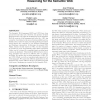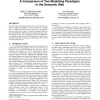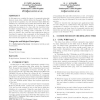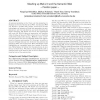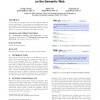WWW
2005
ACM
15 years 6 days ago
2005
ACM
The Semantic Web languages RDFS and OWL have been around for some time now. However, the presence of these languages has not brought the breakthrough of the Semantic Web the creat...
WWW
2006
ACM
15 years 6 days ago
2006
ACM
Classical logics and Datalog-related logics have both been proposed as underlying formalisms for the Semantic Web. Although these two different formalism groups have some commonal...
WWW
2006
ACM
15 years 6 days ago
2006
ACM
We describe ELVIS (the Ecosystem Location Visualization and Information System), a suite of tools for constructing food webs for a given location. We express both ELVIS input and ...
WWW
2006
ACM
15 years 6 days ago
2006
ACM
In this paper we consider the types of community networks that are most often codified within the Semantic Web. We propose the recognition of a new structure which fulfils the def...
WWW
2007
ACM
15 years 6 days ago
2007
ACM
A common perception is that there are two competing visions for the future evolution of the Web: the Semantic Web and Web 2.0. A closer look, though, reveals that the core technol...
WWW
2007
ACM
15 years 6 days ago
2007
ACM
The success of the Semantic Web depends on the availability of Web pages annotated with metadata. Free form metadata or tags, as used in social bookmarking and folksonomies, have ...
WWW
2007
ACM
15 years 6 days ago
2007
ACM
Master data refers to core business entities a company uses repeatedly across many business processes and systems (such as lists or hierarchies of customers, suppliers, accounts, ...
WWW
2007
ACM
15 years 6 days ago
2007
ACM
DBin is a Semantic Web application that enables groups of users with a common interest to cooperatively create semantically structured knowledge bases. These user groups, which we...
WWW
2008
ACM
15 years 6 days ago
2008
ACM
Easy reuse and integration of declaratively described information in a distributed setting is one of the main motivations for building the Semantic Web. Despite of this claim, reu...
WWW
2008
ACM
15 years 6 days ago
2008
ACM
As of today, the amount of data on the Semantic Web has grown considerably. The services for searching and browsing entities on the Semantic Web are in demand. To provide such ser...
